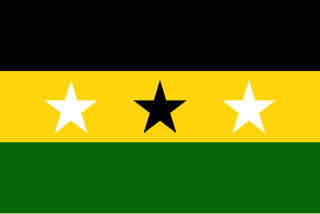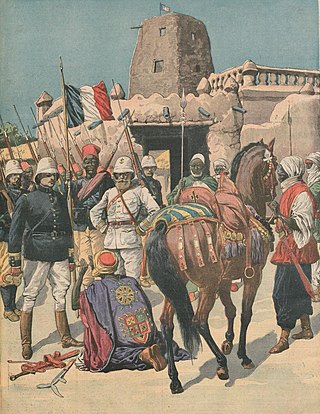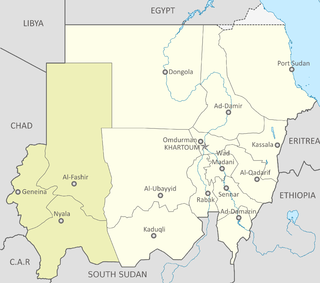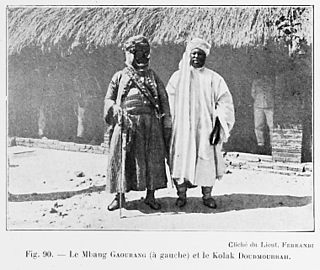
Sudan, officially the Republic of the Sudan, is a country in Northeast Africa. It borders the Central African Republic to the southwest, Chad to the west, Libya to the northwest, Egypt to the north, the Red Sea to the east, Eritrea and Ethiopia to the southeast, and South Sudan to the south. Sudan has a population of 50 million people as of 2024 and occupies 1,886,068 square kilometres, making it Africa's third-largest country by area and the third-largest by area in the Arab League. It was the largest country by area in Africa and the Arab League until the secession of South Sudan in 2011; since then both titles have been held by Algeria. Sudan's capital and most populous city is Khartoum.

The history of Sudan refers to the territory that today makes up Republic of the Sudan and the state of South Sudan, which became independent in 2011. The territory of Sudan is geographically part of a larger African region, also known by the term "Sudan". The term is derived from Arabic: بلاد السودان bilād as-sūdān, or "land of the black people", and has sometimes been used more widely referring to the Sahel belt of West and Central Africa.

Darfur is a region of western Sudan. Dār is an Arabic word meaning "home [of]" – the region was named Dardaju while ruled by the Daju, who migrated from Meroë c. 350 AD, and it was renamed Dartunjur when the Tunjur ruled the area. Darfur was an independent sultanate for several hundred years until 1874, when it fell to the Sudanese warlord Rabih az-Zubayr. The region was later invaded and incorporated into Sudan by Anglo-Egyptian forces in 1916. As an administrative region, Darfur is divided into five federal states: Central Darfur, East Darfur, North Darfur, South Darfur and West Darfur. Because of the War in Darfur between Sudanese government forces and the indigenous population, the region has been in a state of humanitarian emergency and genocide since 2003. The factors include religious and ethnic rivalry, and the rivalry between farmers and herders.

The Masalit are an ethnic group inhabiting western Sudan and eastern Chad. They speak the Masalit language.

The Funj Sultanate, also known as Funjistan, Sultanate of Sennar or Blue Sultanate, was a monarchy in what is now Sudan, northwestern Eritrea and western Ethiopia. Founded in 1504 by the Funj people, it quickly converted to Islam, although this conversion was only nominal. Until a more orthodox form of Islam took hold in the 18th century, the state remained an "African empire with a Muslim façade". It reached its peak in the late 17th century, but declined and eventually fell apart in the 18th and 19th centuries. In 1821, the last sultan, greatly reduced in power, surrendered to the Ottoman Egyptian invasion without a fight.

The Wadai Sultanate, sometimes referred to as the Maba Sultanate, was an African sultanate located to the east of Lake Chad in present-day Chad and the Central African Republic. It emerged in the seventeenth century under the leadership of the first sultan, Abd al-Karim, who overthrew the ruling Tunjur people of the area. It occupied land previously held by the Sultanate of Darfur to the northeast of the Sultanate of Baguirmi.
The Tunjur people are a Sunni Muslim ethnic group living in eastern Chad and western Sudan. In the 21st century, their numbers have been estimated at 175,000 people.
The Maba, also called Bargo or Wadai people, are a Sunni Muslim ethnic group found primarily in the mountains of Wadai region in eastern Chad and southern Sudan. Their population is estimated to be about 542,000. Other estimates place the total number of Bargo people in Sudan to be about 28,000.

The Wadai War, also known as the Ouaddai War, was waged by France and its African allies against the Wadai Empire and its allies from 1906 to 1912. Located in what today would be eastern Chad and western Sudan, Wadai fiercely resisted the French invasion. Regardless, much of Wadai including its capital Abéché fell to the invaders in 1909, forcing the empire's ruler Dud Murra to continue his resistance from outlying provinces and allied states. He managed to gain the support of the Sultanate of Darfur and Dar Masalit, and used these areas as rear bases during his attempts to oust the French. Doing so, he enjoyed some success, and inflicted several defeats on French-led forces. In order to legitimize their intervention, the French installed Dud Murra's relative Adam Asil as puppet ruler in Wadai. After losing most of his forces and allies, Dud Murra was forced to surrender in 1911. Regardless, unrest initially continued: a major anti-French revolt broke out soon after Dud Murra's defeat, and an anti-European conspiracy was allegedly organized with the support of Adam Asil. The last effective anti-French resistance in Wadai was suppressed by 1912 and the region remained a part of French colonial empire until 1960.

Throughout its history, Darfur has been the home to several cultures and kingdoms, such as the Daju and Tunjur kingdoms. The recorded history of Darfur begins in the seventeenth century, with the foundation of the Fur Sultanate by the Keira dynasty. The Sultanate of Darfur was initially destroyed in 1874 by the Khedivate of Egypt. In 1899, the government of Anglo-Egyptian Sudan recognized Ali Dinar as the Sultan of Darfur, in exchange for an annual tribute of 500 pound sterling. This lasted until Darfur was formally annexed in 1916. The region remained underdeveloped through the period of colonial rule and after independence in 1956. The majority of national resources were directed toward the riverine Arabs clustered along the Nile near Khartoum. This pattern of structural inequality and overly underdevelopment resulted in increasing restiveness among Darfuris. The influence of regional geopolitics and war by proxy, coupled with economic hardship and environmental degradation, from soon after independence led to sporadic armed resistance from the mid-1980s. The continued violence culminated in an armed resistance movement around 2003.
The Daju people are a group of seven distinct ethnicities speaking related languages living on both sides of the Chad-Sudan border and in the Nuba Mountains. Separated by distance and speaking different languages, at present, they generally have little cultural affinity to each other.

The Sultanate of Darfur was a pre-colonial state in present-day Sudan. It existed from 1603 to 24 October 1874, when it fell to the Sudanese warlord Rabih az-Zubayr, and again from 1898 to 1916, when it was occupied by the British and the Egyptians and was integrated into Anglo-Egyptian Sudan. At its peak in the late 18th and early 19th century it stretched all the way from Darfur in the west to Kordofan and the western banks of the White Nile in the east, giving it the size of present-day Nigeria.

Muhammad Ali Dinar, known more generally as Ali Dinar, was the last sultan of Darfur and ruler from the Keira dynasty.

Sulayman Solong was the first historical sultan of Darfur. According to several sources, he ruled the Sultanate of Darfur from 1596 to 1637. However, because of the lack of contemporary references, estimates of his reign dates diverge widely, with some modern scholars stating that he probably reigned between 1660 and 1680.
Muhammad 'Abd al-Karim Sabun was (Sultan) of Wadai, a Muslim state in what is now eastern Chad, from 1804 to 1815. He pursued an expansionist policy, and was the greatest of the rulers of Wadai.

Muhammad Salih bin Yusuf, known as Dud Murra or Dudmurrah, was the last independent ruler, or kolak, of the Wadai Empire. He allied with the Sanusi, powerful traders of the eastern Sahara, and with the Sultan of Darfur to resist French aggression in the eastern Sahel, but was defeated. His sultanate was incorporated in the French military territory of Chad.
The Tora are a semi-legendary culture that existed in Jebel Marra, Darfur. In local oral traditions they appear as "white giants" who arrived in Darfur from somewhere in the north, which might be a hint to them originally being Berbers. They are credited with the introduction of monumental stone architecture, advanced stone-working techniques and agriculture techniques like terrace farming, irrigation and palm tree cultivation. By the 12th century the Tora culture had been succeeded by the Daju.

The Daju kingdom was a medieval monarchy that existed in Darfur (Sudan) from possibly the 12th–15th century. Its name stems from the Daju people, the ruling ethnic group. The Daju were eventually ousted from power by the Tunjur and the last Daju king subsequently fled to present-day Chad. The sources for the Daju kingdom are almost entirely local traditions collected in the 19th and 20th century and mentions by medieval Arab historians.
Rex Seán O'Fahey was an Irish historian specializing in Islamic Africa. He was especially known for his work on Sudan and on Sufism.












